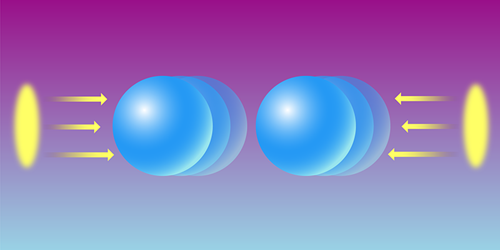By the Left, Quick March
When it comes to manipulating particles with light, a key determinant of how the particles will move is their size relative to the wavelength of the light. Researchers have extensively studied what happens at the extremes of the parameter range, where the particles are significantly larger or smaller than the wavelength of light. Less attention has been paid to systems where those two lengths are roughly equal. Now, Xiao-Yong Duan of Jiaxing University, China, and colleagues predict that in this regime, two identical particles can asymmetrically interact with two identical light beams, resulting in the particles moving off together to one side of the system [1]. The team says that the finding has implications for operating light-driven nanomotors and other nanomachines.
The team considers two identical dielectric spheres in air. They apply to the spheres two identical light beams, whose wavelength is close to the diameter of the spheres. The team predicts that for counterpropagating beams, the light will induce similar but slightly asymmetric charge and current oscillations in the spheres.
Because of these asymmetric states, the spheres asymmetrically scatter the light beams. The details of this scattering depend on the intersphere distance, such that the particles can attract or repel each other. In the latter case, the repelling force leads to the particles “marching” in a straight line along the path of one of the beams. Duan says that this behavior lay unseen until now, as previous models overlooked the magnetic forces of the system. When the particles are much smaller or larger than the wavelength of light, magnetic contributions are negligible, he says, but that is clearly not the case in the intermediate regime.
–Katherine Wright
Katherine Wright is the Deputy Editor of Physics Magazine.
References
- X. Y. Duan et al., “Asymmetric longitudinal optical binding force between two identical dielectric particles with electric and magnetic dipolar responses,” Phys. Rev. A 106, 013108 (2022).




